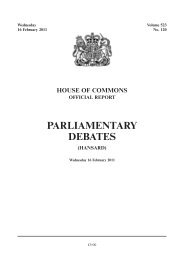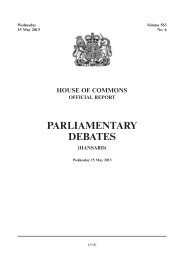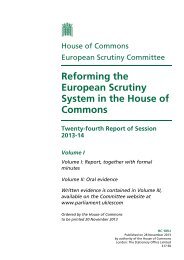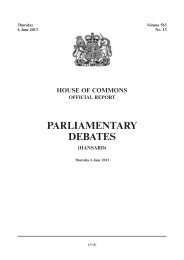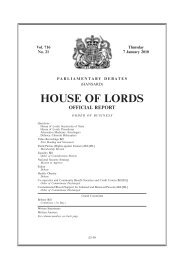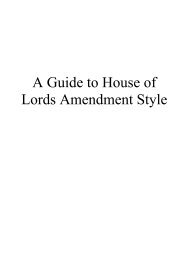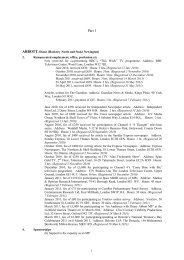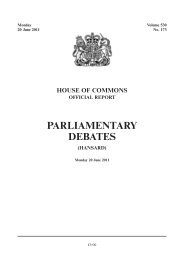Ticketing and Concessionary Travel on Public Transport - United ...
Ticketing and Concessionary Travel on Public Transport - United ...
Ticketing and Concessionary Travel on Public Transport - United ...
Create successful ePaper yourself
Turn your PDF publications into a flip-book with our unique Google optimized e-Paper software.
<strong>Transport</strong> Committee: Evidence Ev 115<br />
were to be firmly applied, a vital corollary would be that the operator provided adequately-staVed bookingoYces,<br />
to avoid more than the very shortest ticket-queues no matter how busy the lines were. Without such<br />
a commitment, enforcing limits <strong>on</strong> what a train-c<strong>on</strong>ductor can issue from staVed stati<strong>on</strong>s is tantamount to<br />
punishing some of the travelling public for the shortcomings of the service-provider, <str<strong>on</strong>g>and</str<strong>on</strong>g> is to be deplored.<br />
By the same token, however, operators of rail <str<strong>on</strong>g>and</str<strong>on</strong>g> bus services need to see that all who travel pay their<br />
due fare. This means than the fare-structures are simple enough to allow passengers to underst<str<strong>on</strong>g>and</str<strong>on</strong>g> them<br />
readily, <str<strong>on</strong>g>and</str<strong>on</strong>g> fare-collectors to sell tickets to all who need them, even when unstaVed stati<strong>on</strong>s are close<br />
together, <str<strong>on</strong>g>and</str<strong>on</strong>g> numbers using each <strong>on</strong>e are comparatively high. Similar points apply to bus operati<strong>on</strong>s in that<br />
ticket-issue methods should minimise the length of a queue outside a vehicle at busy stops, especially those<br />
in town centres. Again, a carnet approach is a largely-untried but very simple way to achieve this.<br />
7. (a) What appeals mechanisms exist for passengers?<br />
Without better knowledge of what these mechanisms are, it is diYcult to answer this. ”C<strong>on</strong>diti<strong>on</strong>s of<br />
Carriage” notices are rarely found <strong>on</strong> bus-stop poles, or even at some rail stati<strong>on</strong>s. The recent demise of<br />
regi<strong>on</strong>al Rail Users’ C<strong>on</strong>sultative Committees has made it more diYcult for rail travellers to find out that<br />
such appeals are possible at all, never mind to decide where best to address them.<br />
(b) Are they adequate?<br />
A fortiori, no. It in any case depends <strong>on</strong> the nature of the complaint, <str<strong>on</strong>g>and</str<strong>on</strong>g> the character <str<strong>on</strong>g>and</str<strong>on</strong>g> persistence of<br />
the pers<strong>on</strong> who wishes to make it.<br />
8. Are the rights of passengers <str<strong>on</strong>g>and</str<strong>on</strong>g> the powers of ticket-inspectors well-balanced?<br />
Here again, generalised comment borders <strong>on</strong> the futile. C<strong>on</strong>diti<strong>on</strong>s of work vary between bus, local train,<br />
tram, metro, <str<strong>on</strong>g>and</str<strong>on</strong>g> l<strong>on</strong>ger-distance rail services. There are awkward customers, <str<strong>on</strong>g>and</str<strong>on</strong>g> there are (some) awkward<br />
inspectors, but it is reassuring that, increasingly nowadays, staV training <strong>on</strong> all modes of travel emphasises<br />
how best to h<str<strong>on</strong>g>and</str<strong>on</strong>g>le passengers whose tickets are invalid or mis-issued, to avoid c<strong>on</strong>flict <str<strong>on</strong>g>and</str<strong>on</strong>g> to maintain basic<br />
human respect—in both directi<strong>on</strong>s.<br />
This is easier aspired to than attained; <str<strong>on</strong>g>and</str<strong>on</strong>g> the eVorts <str<strong>on</strong>g>and</str<strong>on</strong>g> patience required of inspecti<strong>on</strong> staV are<br />
c<strong>on</strong>siderable, as well as frequently under-estimated by some of the travelling public. On buses, particularly,<br />
where a passenger is causing trouble for whatever reas<strong>on</strong>, the steps needed for an inspector to gain oYcial<br />
back-up are prohibitively cumbersome <str<strong>on</strong>g>and</str<strong>on</strong>g> time-c<strong>on</strong>suming. Bus operators do not like their buses being held<br />
up for several minutes or more, even for a police reinforcement to arrive. Neither, it must be said, do other<br />
passengers, who in such circumstances simply wish to c<strong>on</strong>tinue their journey to its end, <str<strong>on</strong>g>and</str<strong>on</strong>g> then to leave<br />
the vehicle rapidly.<br />
9. Do operators of public transport take adequate measures to protect fares revenue?<br />
This is yet another case where generalisati<strong>on</strong> is virtually impossible. Some operators have at times been<br />
guilty of over-kill (eg in central Manchester, at Oxford Road stati<strong>on</strong>, then at Piccadilly stati<strong>on</strong>, half a mile<br />
further <strong>on</strong>, for those who have to change trains there in a hurry). With better applicati<strong>on</strong> of discreti<strong>on</strong> <str<strong>on</strong>g>and</str<strong>on</strong>g><br />
experienced judgement, this has eased oV recently. As stated earlier, there is always the potential c<strong>on</strong>flict<br />
between seeing, especially at busy times, that all passengers pay their fare, <str<strong>on</strong>g>and</str<strong>on</strong>g> annoying the majority who<br />
have d<strong>on</strong>e so by asking them repeatedly to prove this. Mainly, this is a rail problem, since few buses permit<br />
n<strong>on</strong>-payers to get far bey<strong>on</strong>d the driver’s cab-side. But cf points made about bus fare-collecti<strong>on</strong> in Questi<strong>on</strong>s<br />
1, 3, 5 <str<strong>on</strong>g>and</str<strong>on</strong>g> 6 passim. The apparently-irrec<strong>on</strong>cilable aims of making public transport attractive enough to<br />
tempt car-users to change to it, <str<strong>on</strong>g>and</str<strong>on</strong>g> of seeing that all pay what they are supposed to pay, can become far<br />
more attainable, we feel, if there are more carnet facilities <strong>on</strong> every type of public transport—<str<strong>on</strong>g>and</str<strong>on</strong>g> we make<br />
no apology for repeating this point yet again here.<br />
<str<strong>on</strong>g>C<strong>on</strong>cessi<strong>on</strong>ary</str<strong>on</strong>g> Fares—the Right Strategy?<br />
10. Is the Government’s c<strong>on</strong>cessi<strong>on</strong>ary fares strategy, including the proposed scheme for c<strong>on</strong>cessi<strong>on</strong>ary bus<br />
travel, adequate?<br />
In short, no. The free travel for OAPs <str<strong>on</strong>g>and</str<strong>on</strong>g> the disabled, welcome though it is to its users, has caused<br />
financial problems at various points: the bus operators quote a nominal average ’fare’ for each free ticket<br />
issued, <str<strong>on</strong>g>and</str<strong>on</strong>g> a local council, evidently, has to compensate the bus operators accordingly. Not all councils have<br />
adequate finance to do this, evidently, <str<strong>on</strong>g>and</str<strong>on</strong>g> have to decide, rightly or wr<strong>on</strong>gly, to reduce the levels of<br />
“maintained” bus services, particularly in evenings when buses are few <str<strong>on</strong>g>and</str<strong>on</strong>g> far between anyway. It looks to<br />
us as though much greater funding-levels are required than are now made available, <str<strong>on</strong>g>and</str<strong>on</strong>g> that the problem<br />
will get worse in 2008, when the scheme goes nati<strong>on</strong>-wide.



